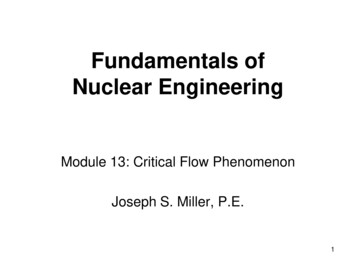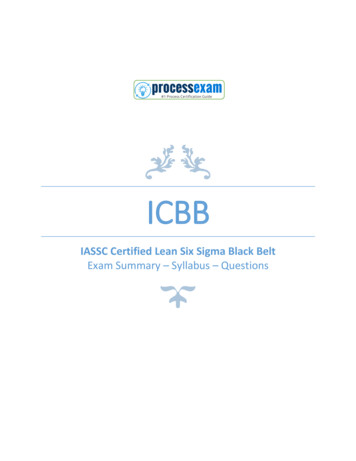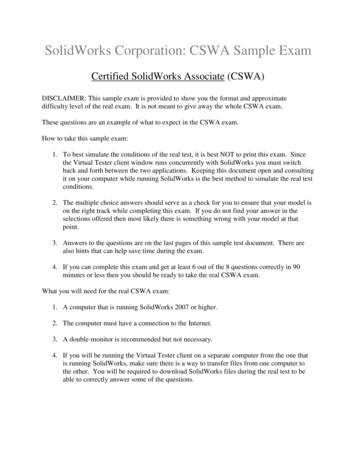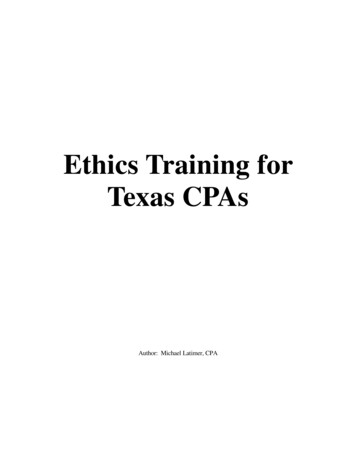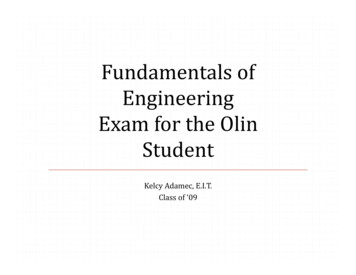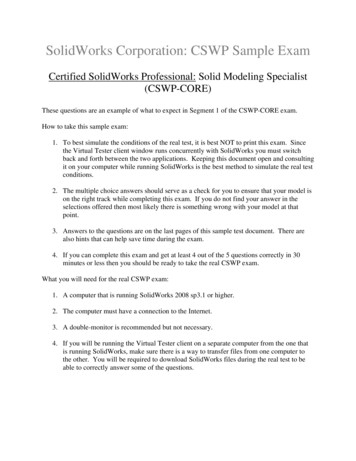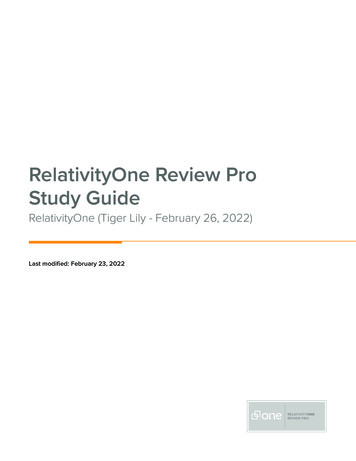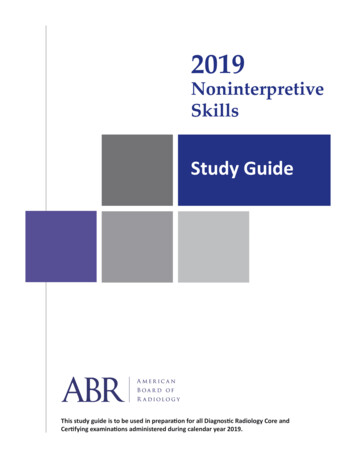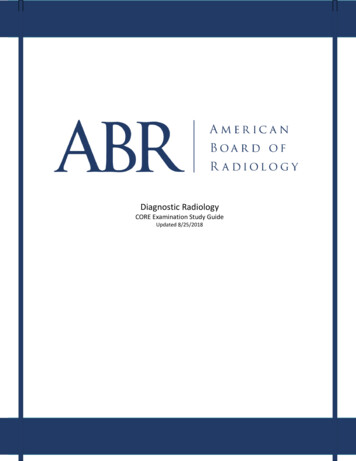
Transcription
Diagnostic RadiologyCORE Examination Study GuideUpdated 8/25/2018
Core Examination Study GuideContentsContentsPreamble . 3Exam Purpose Statements .4Breast Imaging . 5Cardiac Imaging.7Gastrointestinal Imaging. 12Interventional Radiology. 18Musculoskeletal Imaging . 20Neuroradiology . 30Nuclear Radiology . 45Pediatric Radiology . 58Physics. 78Radioisotope Safety Examination (RISE) . 95Reproductive/Endocrine Imaging and Therapy . 98Noninterpretive Skills.100Thoracic Imaging .102Ultrasound . .110Urinary Imaging. .132Vascular Imaging . 135Core Examination Study GuidePage 2
Core Examination Study GuidePreamblePreambleThis study guide is a resource to guide your preparation for the Core Examination indiagnostic radiology.The Core Examination is designed to evaluate a candidate’s core radiology knowledge andclinical judgement, across both the subspecialties and imaging modalities of diagnosticradiology. It tests knowledge and comprehension of anatomy, pathophysiology, diagnosticradiology, and physics concepts important for the practice of diagnostic radiology. Thepurpose of this exam relative to that of other ABR exams is given on the next page.The 18 categories are: breast imaging, cardiac imaging, computed tomography (CT),gastrointestinal (GI) imaging, interventional radiology, magnetic resonance (MR),musculoskeletal imaging, neuroradiology, nuclear radiology, pediatric radiology, physics,radiography/fluoroscopy, reproductive/endocrine imaging, noninterpretive skills, thoracicimaging, ultrasound (US), urinary imaging, and vascular imaging. Individual category study guides are presented for 15 categories.For the three modalities of CT, MR and radiography/fluoroscopy, the relevant portionof the study guides in each of the other categories should be used to guidepreparation.In general, the Core Examination is based on material in this study guide. However, not allmaterial in the study guide is included on every form of the examination. Items that arenot included in this study guide may appear on the examination.If you are reviewing this in printed format, please be sure to check the ABRwebsite, www.theabr.org, for updated study guide materials and questions.Nonprofit educational programs have permission to use or reproduce all or parts of this document for educational purposesonly. Use or reproduction of this document for commercial use or for-profit use is strictly prohibited. American Board of Radiology, 2013Core Examination Study GuidePage 3
Core Examination Study GuideExam Purpose StatementsExam Purpose StatementsCore Exam:The purpose of the ABR Core (qualifying) Exam is to validate that the candidate hasacquired the knowledge, skills, and understanding basic to the entire field of diagnosticradiology, including physics.Certifying Exam:The purpose of the ABR Certifying Exam is to validate that the candidate has acquired andis able to apply the requisite knowledge, skills, and understanding that:1. every practicing physician should possess (20%).2. every practicing radiologist should possess (20%).3. this particular practicing radiologist should possess to begin independent practice inhis or her chosen clinical practice area(s) (60%).Subspecialty Certifying Exams:The purpose of the subspecialty certifying exam is to validate that the candidate has acquiredand is able to apply the requisite knowledge, skills, and understanding essential to thepractice of the subspecialty.Maintenance of Certification (MOC) Exam:The purpose of the MOC exam is to validate that the certified diplomate has maintained andapplies the essential knowledge, skills, and understanding in the major clinical areas in which thediplomate currently practices.Core Examination Study GuidePage 4
Core Examination Study GuideBreast ImagingBreast Imaging1) Regulatory/Standards of Carea) Components and desired goals of the medical audit for breast cancer detectionb) Appropriate application of the Breast Imaging Reporting and Data System (BI-RADS)terminology and assessment categoriesc) Mammography Quality Standards Act (MQSA) requirementsd) Quality determinants of mammography, breast ultrasound, and breast MR, includingpositioning, image processing, artifacts, optimal technique, and equipment2) Screeninga) Indicationsb) Normal anatomy (mammography, ultrasound, MR)c) Lesion detection and localizationd) Computer-aided detectione) Breast cancer risk factors, including the identification and management of women athigh risk for breast cancer3) Diagnostic Breast Imaginga) Appropriate mammographic views for work-up of a breast lesionb) Evaluate and manage women and men with breast symptomsi) Palpable massesii) Breast thickeningiii) Nipple dischargeiv) Nipple retractionv) Skin changesc) Appearance and management of inflammatory processes in the breasti) Benignii) Malignantd) Role of imaging in surgical staging and surgical planning in women with recentlydiagnosed breast cancere) Normal and abnormal appearance after surgical proceduresi) Breast implantsii) Breast augmentationiii) Breast reductioniv) Breast reconstructionv) Normal and abnormal appearance of breast-conserving therapy4) Pathologya) Appearance and management of benign breast lesions, high-risk lesions, ductalcarcinoma in situ, invasive ductal carcinoma, and other special types of breastcarcinomab) Appearance and causes of benign and malignant male breast disease5) Imaging findingsCore Examination Study GuidePage 5
Core Examination Study GuideBreast Imaginga) Characteristics of benign and malignant breast calcificationsb) Characteristics of benign and malignant breast massesc) Identify and appropriately manage imaging findingsi) Mammography(1) Abnormal calcifications(2) Masses(3) Asymmetries(4) Architectural distortionii) Ultrasoundiii) Breast MR(1) Masses(2) Non-mass findingsd) Identify and understand the causes of abnormal lymph nodes on mammography,ultrasound, or MRI6) Breast Interventiona) Percutaneous breast biopsy techniquesi) Wire localizationii) Core biopsyiii) Vacuum-assisted biopsyiv) Fine-needle aspirationv) Galactographyvi) Cyst aspirationb) Specimen radiographyc) Concordant versus discordant percutaneous biopsy results for imaging appearance of abreast abnormality and appropriate managementd) Patient safety7) Physicsa) Mechanism of obtaining and optimizing film-screen or digital mammogramsi) Target/filter combinationsii) Use of a gridiii) Reduction of scatteriv) Radiation doseb) Adjustment of mammography techniques for special cases, including thin breastsc) Mechanism of obtaining and optimizing breast US imagesd) Mechanism of obtaining and optimizing breast MR imagese) Recognizing, understanding, and correcting artifacts in breast imaging, includingmammography, US, and MR imagingf) Workstation display of digital mammogramsi) Required equipment parametersii) Image processingComputer-assisted display software for breast MRI, including the role of dynamic enhancementcharacteristicsCore Examination Study GuidePage 6
Core Examination Study GuideCardiac ImagingCardiac Imaging1) Basics of Imaging: Radiography, CT, and MRa) Indications and limitations of the modalities and comparison to echocardiography,angiography and cardiac catheterization, SPECT, and PET.b) Physics behind image creation and potential artifacts on radiography, CT, and MRi) X-ray physicsii) CT physics(1) Multidetector CT artifacts relevant to cardiac imaging(2) Tradeoffs between noise, dose and image quality(3) Spatial resolution, contrast resolution, and imaging reconstruction algorithms(4) Temporal resolution, half scan, and multi-segment reconstruction(5) Contrast injection—principles, protocols, bolus geometry, and iodine fluxiii) MR physics(1) MR artifacts relevant to cardiac and vascular imaging(2) Trade-off between spatial resolution, temporal resolution, contrast resolution,and acquisition time(3) Principles of black blood, edema, and scar imaging(4) Steady-state free precession cine imaging(5) Velocity-encoded cine (phase contrast) imaging—principles, applications, andlimitationsc) 3D imaging and post-processingi) Multiplanar reconstruction (MPR)ii) Maximum intensity projection (MIP)iii) Volume rendering (VR)d) Patient safetyi) Radiation exposure and how technical modifications may modifydose ii) Drugs and contrast agents used for cardiac imagingiii) Cardiac devices and the effect of the magnetic field of the MR unit2) Normal Anatomy, Including Variants, Encountered on Radiography, CT, and MRa) Heart, including chambers, valves, pericardium, and coronary arteriesb) Aorta and pulmonary arteriesc) Venae cavae and pulmonary veins3) Physiological Aspects of Cardiac Imaging as Assessed with Radiography, CT, and MRa) Normal cardiac cycleb) Physiological anatomy of cardiac musclec) Mechanics of cardiac contractiond) Physical basis for blood flow, pressure, and resistancei) Ventricular volume and pressure relationshipii) Functional cardiac measurementsCore Examination Study GuidePage 7
Core Examination Study GuideCardiac Imaging(1) Ejection fraction(2) Stroke volume(3) Left ventricular mass(4) Flow (Q V x A)(5) Pressure gradient (modified Bernoulli equation, ΔP 4v2)(6) Pulmonary-to-systemic flow (Qp/Qs) ratio(7) Regurgitant volume and regurgitant fraction(8) Diastolic heart functioniii) Normal cardiac and pulmonary pressuresiv) Vascular regions supplied by the coronary arteries4) Ischemic Heart Diseasea) Risk factors, primary prevention, and screeningb) Roles of echocardiography, angiography, SPECT, PET, CT, and MR in the evaluation of apatient with suspected ischemic heart disease, including the advantages and limitationsof each modalityc) Inducible myocardial ischemiad) Acute myocardial infarctione) Chronic myocardial infarctionf) Post-myocardial infarction complicationsi) Cardiac ruptureii) Left ventricular aneurysm and pseudoaneurysmiii) Papillary muscle ruptureiv) Congestive heart failurev) Dressler syndromeg) Myocardial perfusion and viabilityi) Stunned myocardiumii) Hibernating myocardiumh) Role of myocardial delayed-enhancement imaging in guiding management of leftventricular dysfunctioni) Coronary artery stenosis and aneurysmj) Role of coronary CT angiography in guiding management of chest paink) Therapeutic and interventional options5)Cardiomyopathya) Hypertrophicb) Dilatedc) Restrictivei) Distinguish restrictive cardiomyopathy from constrictive pericarditisd) Arrhythmogenic right ventricular dysplasiae) Therapeutic and interventional options6) Cardiac Massesa) ThrombusCore Examination Study GuidePage 8
Core Examination Study Guideb)c)d)e)Cardiac Imagingi) Distinguish thrombus from tumorPrimary benign tumorsi) Myxomaii) Lipomaiii) Rhabdomyomaiv) Fibromav) Lipomatous hypertrophy of the interatrial septumPrimary malignant tumorsi) Angiosarcomaii) LymphomaMetastasisTherapeutic and interventional options7) Valvular Diseasea) Myxomatous degenerationb) Rheumatic heart diseasec) Infective endocarditisd) Congenital valve diseasee) Specific lesionsi) Aortic stenosisii) Aortic regurgitationiii) Mitral stenosisiv) Mitral regurgitationv) Mitral annular calcificationvi) Tricuspid regurgitationvii) Pulmonary stenosisviii) Pulmonary regurgitationf) Therapeutic and interventional options8) Pericardial Diseasea) Acute pericarditisb) Constrictive pericarditisi) Distinguish restrictive cardiomyopathy from constrictivepericarditis c) Pericardial effusioni) Hemopericardiumii) Tamponaded) Pericardial cyste) Pericardial defectf) Pneumopericardiumg) Therapeutic and interventional options9) Congenital Heart Diseasea) Left-to-right shuntsi) Atrial septal defectCore Examination Study GuidePage 9
Core Examination Study GuideCardiac Imagingii) Ventricular septal defectiii) Partial anomalous pulmonary venous connection(1) Scimitar syndromeiv) Patent ductus arteriosusb) Eisenmenger syndromec) Admixture lesions (bidirectional shunts)i) Transposition of the great arteriesii) Truncus arteriosusiii) Total anomalous pulmonary venous connectiond) Right-to-left shuntsi) Tetralogy of Fallot and pulmonary atresia with ventricular septal defectii) Ebstein anomalye) Great vessel anomaliesi) Coarctation of the aorta(1) Distinguish from pseudocoarctationii) Double aortic archiii) Right aortic arch(1) Mirror image(2) Non-mirror imageiv) Pulmonary slingv) Persistent left superior vena cavaf) Coronary artery anomaliesi) Retroaortic courseii) Interarterial courseg) Miscellaneous anomaliesi) Cardiac malposition, including situs abnormalitiesii) Congenitally corrected transposition of the great arteriesh) Therapeutic and interventional options10) Acquired Disease of the Thoracic Aorta and Great Vesselsa) Aneurysmsi) Atheroscleroticii) Marfan syndromeiii) Ehlers-Danlos syndromeb) Pseudoaneurysmsi) Mycoticii) Post-traumatic and post-surgicalc) Dissectioni) Intramural hematomad) Aortitis and arteritise) Atherosclerosisi) Plaqueii) Ulcerated plaqueiii) Penetrating ulcerCore Examination Study GuidePage 10
Core Examination Study GuideCardiac Imagingf) Thromboembolismi) Acute pulmonary embolismii) Chronic pulmonary embolismg) Pulmonary hypertensionh) Pulmonary arteriovenous malformationi) Compressioni) Superior vena cava syndromej) Pulmonary vein complications after radiofrequency ablationk) Therapeutic and interventional options11) Devices and Postoperative Appearancea) Monitoring and support devicesi) Intra-aortic balloon pumpii) Pacemaker generator and pacemaker leadsiii) Implantable cardiac defibrillatoriv) Left ventricular assist devicev) Pericardial drainb) Postoperative chesti) Coronary artery bypass graft surgeryii) Cardiac valve replacementiii) Transluminal septal closure iv)Aortic graft and aortic stent v)Heart transplantCore Examination Study GuidePage 11
Core Examination Study GuideGastrointestinal ImagingGastrointestinal Imaging1) Pharynxa) Benign diseasesi) Zenker diverticulumii) Foreign bodiesiii) Traumab) Motility disorders2) Esophagusa) Benign diseasesi) Diverticulaii) Traumaiii) Esophagitis(1) Reflux(2) Infectious(3) Caustic(4) Drug-inducediv) Barrett esophagusv) Rings, webs, and stricturesvi) Varicesvii) Benign tumors and tumor-like conditionsviii) Extrinsic processes affecting the esophagus(1) Pulmonary lesions(2) Mediastinal structuresix) Hiatal hernia (types and significance)b) Malignant tumorsi) Squamousii) Adenocarcinomasiii) Other malignant tumors(1) Lymphoma(2) Kaposi(3) Metastases (lymphatic and hematogenous)c) Motility disordersi) Primary motility disordersii) Secondary motility disordersd) Postoperative esophagus3) Stomacha) Benign diseasesi) Diverticulaii) Gastritis(1) ErosiveCore Examination Study GuidePage 12
Core Examination Study GuideGastrointestinal Imaging(2) Atrophic(3) Infectious(4) Other(a) Crohn diseaseiii) Peptic ulcer diseaseiv) Hypertrophic gastropathyv) Varicesvi) Volvulusvii) Entrapment after diaphragmatic injuryb) Malignant diseasesi) Primary(1) Adenocarcinoma(2) Lymphoma(3) GI stromal tumors(4) Carcinoidii) Metastaticc) Postoperative stomachi) Expected surgical appearance(1) Bariatric, including gastric banding(2) Nissen and other fundoplications(3) Whipple(4) Billroth proceduresd) Complications4) Duodenuma) Benign diseasesi) Congenital abnormalitiesii) Diverticulaiii) Traumaiv) Inflammation (1)Duodenitis (2)Ulcer disease(3) Crohn diseasev) Aortoduodenal fistulavi) Benign tumorsb) Malignant diseases(1) Adenocarcinoma(2) Lymphoma(3) Metastatic disease5) Small Intestinea) Benign diseasesi) Congenital disordersii) DiverticulaCore Examination Study GuidePage 13
Core Examination Study GuideGastrointestinal Imagingiii) Traumaiv) Vascular diseases(1) Intestinal ischemia and infarction(2) Radiation enteritis(3) Scleroderma(4) Vasculitides(a) Henoch-Schönlein purpura(b) Polyarteritis nodosa(c) Systemic lupus erythematosusv) Malabsorption(1) Sprue(2) Lymphangiectasiavi) Inflammatory diseases(1) Crohn disease(2) Infectious and parasitic diseasesvii) Benign tumors(1) Sporadic(2) Associated with polyposis syndromesviii) Malrotation/Volvulusix) Obstructionx) Hemorrhagexi) Other(1) Status post bone marrow transplant(2) Drug effects(a) NSAIDs enteritis(b) ACE inhibitorsb) Malignant tumorsi) Adenocarcinomaii) Lymphomaiii) Carcinoidiv) GI stromal tumorsv) Metastases6) Colon and Appendixa) Benign diseasei) Congenital abnormalitiesii) Diverticular diseaseiii) Inflammatory diseases(1) Crohn disease(2) Ulcerative colitis(3) Infectious colitis(a) Pseudomembranous(b) Viral(c) BacterialCore Examination Study GuidePage 14
Core Examination Study GuideGastrointestinal Imaging(d) Colitis in AIDS(4) Appendicitisiv) Ischemic colitisv) Benign neoplasms(1) Adenoma(2) Mesenchymal tumors(3) Polyposis syndromesb) Malignant diseasesi) Adenocarcinomaii) Other malignant tumors(1) Lymphoma(2) Carcinoid(3) Melanoma(4) Squamous (anal)(5) Metastases7) Pancreasa) Congenital abnormalities and variantsb) Pancreatitisi) Acuteii) Chroniciii) Complicationsiv) Autoimmunec) Pancreatic neoplasmsi) Duct cell adenocarcinomaii) Cystic pancreatic neoplasms(1) Intraductal papillary mucinous neoplasm (IPMN)(2) Mucinous cystadenomas(3) Serous cystadenomasiii) Islet cell tumorsiv) Lymphomav) Metastases8) Livera) Normal anatomyb) Diffuse diseases of the liveri) Cirrhosisii) Diseases associated with infiltration(1) Fatty infiltration/nonalcoholic steatohepatitis (NASH)/NAFLD(2) Hemochromatosis(3) Storage diseasesiii) Vascular diseases(1) Portal hypertension(2) Portal vein occlusionCore Examination Study GuidePage 15
Core Examination Study GuideGastrointestinal Imaging(3) Hepatic venous hypertension/Budd Chiari syndrome, and nutmeg liverc) Focal diseases of the liveri) Benign(1) Cavernous hemangioma(2) Liver cell adenoma(3) Focal nodular hyperplasiaii) Malignant(1) Hepatocellular carcinoma(2) Metastases(3) Other malignant liver lesionsd) Liver transplantation(1) Surgical candidates(2) Expected postoperative appearance(3) Complications9) Spleena) Splenomegalyb) Focal lesionsi) Cystsii) Hemangiomaiii) Infarctioniv) Abscess/microabscessesv) Granulomatous diseasec) Trauma10) Bile Ducts and Gallbladderi) Congenital abnormalities and variants(1) Choledochal cysts(2) Caroli diseaseii) Inflammatory diseases(1) Gallbladder(a) Acute cholecystitis(b) Emphysematous cholecystitis(c) Porcelain bladder(2) Biliary ducts(a) Primary sclerosing cholangitis(b) Ascending cholangitis(c) Recurrent pyogenic cholangitis(d) AIDS cholangiopathy(e) Ischemic injury(f) Surgical injury(g) Stone diseaseiii) Tumors(1) Gallbladder cancerCore Examination Study GuidePage 16
Core Examination Study GuideGastrointestinal Imaging(2) Cholangiocarcinoma(3) Metastases11) Peritoneal Spacesa) Normal anatomyb) Fluid collectionsc) Diseases of the peritoneumi) Inflammatory diseases(1) Bacterial peritonitis(2) Tuberculosis(3) Otherii) Primary tumorsiii) Metastatic tumorsd) Mesenteriesi) Normal anatomyii) Pathologic conditions(1) Sclerosing mesenteritis/misty mesentery(2) Mesenteric fibromatosise) Retroperitoneumi) Normal anatomyii) Retroperitoneal spacesiii) Benign diseases(1) Fibrosis(2) Inflammatory diseasesiv) Malignant tumors12) Multisystem Disordersa) Acute abdomenb) Trauma to the abdomenc) Syndromes involving the GI tractd) Hernias, including internal herniase) All obstructionCore Examination Study GuidePage 17
Core Examination Study GuideInterventional RadiologyInterventional Radiology1) Basic ProceduresQuestions will assess whether the candidate possesses the knowledge, skills, andabilities needed for safe and effective care before, during, and after the procedure.Candidates are expected to have a detailed knowledge of the procedure itself, as well aspre- and postprocedure care.a) Biopsies: neck, chest, abdomen, pelvis, and extremities, including thyroid, lung, chestwall, liver, pancreas, renal, retroperitoneal, pelvic, and extremity. Note: breastbiopsies will be covered in the mammography section. Bone biopsies will be coveredin the musculoskeletal section.b) Aspirations: neck, chest, abdomen, pelvis, and extremities including thyroid, pleural,peritoneal, and abdominal/pelvic/extremity cysts. Note that lumbar punctureand myelography will be covered in the neuroradiology section.c) Central venous: PICCs and uncomplicated non-tunneled cathetersd) Abscess drainage: uncomplicated chest, abdomen, pelvic, and superficial abscessese) Extremity venographyf) Catheter injections: cholangiography, abscessogram, nephrostograms, and feedingtube checks2) Complex ProceduresBecause these procedures are typically performed by radiologists with morespecialized training, Core Exam candidates are not expected to possess the knowledge,skills, and abilities required to perform these procedures. However, candidates areresponsible for a general knowledge of these procedures. Test items will also coverpre- and postprocedure care in more detail because general radiologists are often thefirst to encounter patients whose clinical presentation and imaging findings warrantthese complex interventions. Candidates are also expected to correctly distinguishbetween expected and unexpected clinical and imaging findings after theseprocedures.a) Arteriography and arterial interventions, including angioplasty, stent placement, stentgraft placement, lysis, embolization, thrombectomy, and therapeutic infusionb) Central venography and venous interventions, including inferior vena cava (IVC) filterplacement, IVC filter retrieval, angioplasty, stent placement, lysis, thrombectomy,sclerosis, tunneled/implanted catheter placement, dialysis interventions, and TIPSc) Biliary interventions, including percutaneous transhepatic cholangiography (PTC),internal/external drainage, stent placement, stone removal, and percutaneouscholecystostomyd) Nephrostomy and ureteral stent placement, manipulation, and exchangee) Tumor ablation (radiofrequency, cryoablation, bland embolization,chemoembolization, and radioembolization)f) Feeding tube placement, manipulation, and exchangeg) Complicated drainages, including transrectal drainage, tunneled catheter placement forpleural/peritoneal collections, and pediatric proceduresCore Examination Study GuidePage 18
Core Examination Study GuideInterventional Radiology3) Physics Knowledge Needed to Safely Perform These Proceduresa) Optimal use of radiationb) Imaging artifactsCore Examination Study GuidePage 19
Core Examination Study GuideMusculoskeletal ImagingMusculoskeletal Imaging1) Imaging Techniques—Indications and Limitationsa) Musculoskeletal modalitiesi) Radiographyii) CTiii) MRIiv) Nuclear scintigraphy/PETv) Ultrasoundvi) Fluoroscopyvii) Considerations for musculoskeletal modalities(1) Appropriateness, limitations, contraindications, and safety issues(2) Protocols, standard positioning, technique(3) Indications for contrast with MRI and CT(4) Scintigraphic agents(5) Artifacts and pitfallsb) Interventional musculoskeletal proceduresi) Types(1) Arthrography(2) Joint aspiration and injection(3) Percutaneous biopsy(4) Therapeutic procedureii) Considerations for musculoskeletal procedures(1) Appropriateness, limitations, contraindications, and safety issues(2) Universal protocol(3) Approach and technique(4) Injectate (composition and amount)(5) Laboratory studies(6) Complicationsc) Dual-energy X-ray Absorptiometry (DEXA)i) Indications and follow-upii) WHO classificationiii) DEXA positioningiv) DEXA artifacts and pitfalls2) Normal/Normal Variantsa) Musculoskeletal anatomy pertinent to the various imaging modalitiesb) Primary and secondary ossification centers and sequence of ossificationc) Physiologic radiolucencies and radiodensitiesd) Physiologic bowinge) Sesamoids, accessory ossicles, and related syndromesf) Accessory musclesg) Tug lesionsh) Cortical desmoidCore Examination Study GuidePage 20
Core Examination Study GuideMusculoskeletal Imagingi) Dorsal defect of the patellaj) Glenoid labrum variants3) Congenital Anomalies and Dysplasiasa) Lower extremityi) Developmental hip dysplasiaii) Discoid meniscusiii) Talipes equinovarusiv) Metatarsus adductusv) Pes cavus and planusvi) Tarsal coalitionvii) Proximal focal femoral deficiencyviii) Protrusio acetabuliix) Acetabular versionx) Patella baja and altab) Upper extremityi) Madelung deformityii) Congenital dislocation of the radial headiii) Carpal coalitioniv) Sprengel deformityv) Supracondylar processvi) Radial ray anomalyvii) Ulnar variancec) Spine (see neuroradiology section)d) Diffuse/multifocali) Achondroplasiaii) Osteogenesis imperfectaiii) Sclerosing osseous dysplasias(1) Melorheostosis(2) Osteopathia striata(3) Osteopoikilosisiv) Osteopetrosisv) Cleidocranial dysplasia/dysostosisvi) Neurofibromatosisvii) Cerebral palsyviii) Mucopolysaccharidosisix) Trisomy 21x) Macrodystrophia lipomatosaxi) Nail-patella syndromexii) Wormian bonesxiii) Thanatophoric dwarfxiv) Marfan syndromexv) Tuberous sclerosis4) Infections (including routes of spread and predisposing factors)a) OsteomyelitisCore Examination Study GuidePage 21
Core Examination Study GuideMusculoskeletal Imagingi) Demographicsii) Acute vs subacute vs chronic osteomyelitisiii) Features with different imaging modalitiesiv) Terminologyv) Bacterial vs nonbacterialvi) Congenital syphilisb) Septic arthritis, bursitis, and tenosynovitisc) Soft tissuei) Abscessii) Cellulitisiii) Pyomyositisiv) Gas gangrenev) Necrotizing fasciitisvi) Cat-scratch diseasevii) Cysticercosis5) Tumors and Tumor-Like Conditionsa) Demographicsb) Imaging features and descriptionc) Benign and malignant primary bone lesionsi) Cartilaginous tumors(1) Osteochondroma(2) Enchondroma(3) Chondroblastoma(4) Periosteal chondroma(5) Chondromyxoid fibroma(6) Chondrosarcomaii) Osteogenic tumors(1) Osteoid osteoma(2) Osteoblastoma(3) Osteoma(4) Osteosarcoma(a) Conventional osteosarcoma(b) Telangiectatic osteosarcoma(c) Parosteal (surface) osteosarcomaiii) Fibrohistiocytic tumors(1) Non-ossifying fibromaiv) Ewing sarcomav) Hematopoietic tumors(1) Plasma cell myeloma (Myeloma)(2) Solitary plasmacytoma of bone(3) Primary non-Hodgkin lymphoma of bone(4) Giant cell tumor of bonevi) Notochordal tumors(1) ChordomaCore Examination Study GuidePage 22
Core Examination Study GuideMusculoskeletal Imagingvii) Vascular tumors(1) Hemangiomaviii) Lipogenic and epithelial tumors(1) Lipoma(2) Adamantinomaix) Tumors of undefined neoplastic nature(1) Aneurysmal bone cyst (primary and secondary)(2) Unicameral bone cyst(3) Fibrous dysplasia(4) Osteofibrous dysplasia(5) Langerhans cell histiocytosisd) Bone metastasesi) Primary bone tumor vs metastasesii) Blastic vs. lytic and other differentiatingfeatures e) Tumor syndromesi) Enchondromatosis (Ollier and Maffucci)ii) Polyostotic fibrous dysplasia, McCune-Albright, and Mazabraudiii) Hereditary multiple osteochondromasiv) Neurofibromatosisf) Malignant transformationi) Pagetii) Radiation inducediii) Tumor syndromes (see above)g) Benign and malignant soft tissue tumorsi) Adipocytic tumors(1) Lipoma(2) Liposarcoma(3) Lipomatosis of nerve (fibrolipomatous hamartoma of nerve)ii) Fibroblastic/myofibroblastic tumors(1) Nodular fasciitis(2) Fibromatosis(3) Elastofibroma(4) Dermatofibrosarcoma protuberans(5) Fibrosarcomaiii) So-called fibrohistiocytic tumors(1) Tenosynovial giant cell tumor (includes localized and diffuse forms of pigmentedvillonodular synovitis as well as extra-articular giant cell tumor)iv) Smooth-muscle tumors(1) Leiomyosarcomav) Pericytic tumors(1) Glomusvi) Skeletal-muscle tumors(1) Rhabdomyosarcomavii) Vascular tumors(1) Hemangioma(2) LymphangiomaCore Examination Study GuidePage 23
Core Examination Study GuideMusculoskeletal Imagingviii) Nerve sheath tumors(1) Schwannoma(2) Neurofibroma(3) Malignant peripheral nerve sheath tumorix) Tumors of u
Aug 25, 2018 · purpose of this exam relative to that of other ABR exams is given on the next page. The 18 categories are: breast imaging, cardiac imaging, computed tomography (CT), gastrointestinal (GI) imaging, interventional radiology, magnetic resonance (MR), musculoskeletal imaging, neurora
